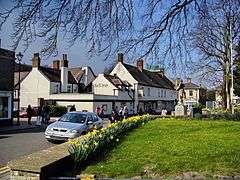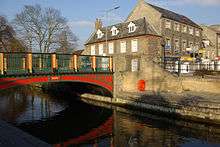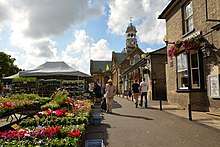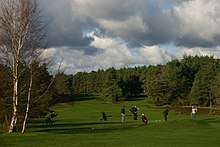Thetford
Thetford is a market town and civil parish in the Breckland district of Norfolk, England. It is on the A11 road between Norwich and London, just east of Thetford Forest. The civil parish, covering an area of 29.55 km2 (11.41 sq mi), has a population of 24,340.[1]
| Thetford | |
|---|---|
 King Street, Thetford | |
 Thetford Location within Norfolk | |
| Area | 29.55 km2 (11.41 sq mi) |
| Population | 24,340 (2011 Census) |
| • Density | 824/km2 (2,130/sq mi) |
| OS grid reference | TL8783 |
| Civil parish |
|
| District |
|
| Shire county | |
| Region | |
| Country | England |
| Sovereign state | United Kingdom |
| Post town | THETFORD |
| Postcode district | IP24 |
| Dialling code | 01842 |
| Police | Norfolk |
| Fire | Norfolk |
| Ambulance | East of England |
| UK Parliament | |
| Website | thetfordtowncouncil.gov.uk |
There has been a settlement at Thetford since the Iron Age, and parts of the town predate the Norman Conquest; Thetford Castle was established shortly thereafter. Roger Bigod founded the Cluniac Priory of St Mary in 1104, which became the largest and most important religious institution in Thetford. The town was badly hit by the dissolution of the monasteries, including the castle's destruction, but was rebuilt in 1574 when Elizabeth I established a town charter. After World War II, Thetford became an "overspill town", taking people from London, as a result of which its population increased substantially.[2] Thetford was the headquarters of Tulip International, large-scale manufacturers of bacon, beef and pork until its closure in 2010.
Thetford railway station is served by the Breckland line and is one of the best surviving pieces of 19th century railway architecture in East Anglia.
Name
The origin of the name Thetford is unclear. The site was an important crossing of the River Little Ouse, so one possibility is that the settlement drew its name from the Anglo-Saxon Theodford or people's ford.[3] It is also unclear if the nearby River Thet is named after the crossing or the later settlement.[4]
History
Early history
Breckland was used as an excavation site for flint tools around 2000BC. During the Iron Age, a fort was established on Icknield Way at the site of Thetford Castle.[3] Thetford was an important tribal centre for the Iceni during the late Iron Age and early Roman period, with Castle Hill and Gallows Hill being sites of particular note.[5] During the Saxon period it was the principal centre of the eastern Heptarchy and a regular battle site between locals and the Viking invaders.[6]
A mint was built in Thetford in the 9th century.[7] A monastery was established around 1020 and a grammar school was operating since before the Norman Conquest of 1066.[3] The town greatly prospered during the reign of Edward the Confessor (1042–1066), and at one point there were 944 free Burgesses living in Thetford.[6] The Domesday Book of 1086 estimated the population of Thetford to have grown to between 4000 and 4500 people, which would have been the sixth largest town in Britain at the time.[7] The Book lists William of Bello Fargo as the Bishop of Thetford at the time.[8] He had moved here from North Elmham in 1071 and stayed in Thetford until moving to Norwich in 1096.[3]
In 1067-9, Thetford Castle was built on the ruins of an Iron Age fort at Castle Hill. It is believed to have been constructed either by Ralph Guader, Earl of East Anglia, or Roger Bigod, his successor as Earl, who is known to have ordered Bungay and Framlingham castles to have been built in Suffolk. In 1104, Bigod founded the Cluniac Priory of St Mary. The priory grew rapidly, with an influx of monks from Lewes, and in 1107 it was moved to a larger side on the other side of the river where the ruins remain today. It became the largest and most important religious institution in Thetford.[9]
The Norfolk Lent Assizes were held at Thetford from 1264 because there was only one Assize for both Norfolk and Suffolk. Thetford, being close to the border between the two, was convenient for both. However, after much pressure, an Act of Parliament was passed in 1832 to transfer them to Norwich.[10] In 1373, John of Gaunt, the Duke of Lancaster, was responsible for altering the administrative makeup of the town, promoting the Mayor to its most important official, subjecting the bailiff and the coroner to report to him. Thetford had its own coroner, courts and legal officials, without depending on those for the counties of Norfolk and Suffolk.[11]
Tudor history to present
_(41772369784).jpg)
Henry VIII sent Anne Boleyn's father, Thomas, as part of a Commission to assess Thetford in 1527. The Commission concluded that the town had fallen into "great ruin and decay" and that the burgesses of the town had squandered rents and dues which belonged to the King. Thetford was struck hard by the Dissolution of the Monasteries in the 1530s and 1540s. A formal complaint was raised by the Mayors and burgesses to Thomas Cromwell in 1539, arguing that many of the town's inhabitants would fall into extreme poverty because their livelihoods depended on pilgrims visiting Thetford. Thetford Priory was closed down in 1540 and fell into the possession of Thomas Howard, 3rd Duke of Norfolk. In 1574, Elizabeth I granted a Charter of Incorporation to the town, setting up a governing body of a Mayor, ten burgesses and twenty commoners to meet in the Guildhall and redevelop the town main streets, houses and shops. Elizabeth arrived in Thetford on 27 August 1578 to survey developments, holding a Privy Council meeting at Sir Edward Clere's Place House, now Nunnery Place.[12] A lot of material from the decaying priory and religious buildings in the town were used to save building costs in the building of King's House and other buildings in Thetford.[7]
In 1819 there was a local desire to develop Thetford into a spa town modelled on Bath, Cheltenham and Harrogate. A pump room was built over the spring at Nuns Bridges and the Thetford Mineral Spring Company was established. The mayor financed a new gravel path along the bank of the Little Ouse, which was named Spring Walk. The plan did not succeed; by 1838 the pump room was closed.[13] In 1835 the old Corporation of Thetford was abolished, and a new one set up a Mayor, four aldermen and twelve councillors. The town was represented by two MPs until 1868 when it lost a seat to Scotland.[14]
Dr Allan Glaisyer Minns, born in Inagua, the Bahamas, Mayor of Thetford in 1904, was the first black man to become a mayor in Britain.[15] In 1912, more than 30,000 troops participated in military manoeuvres on the heath land outside the town. Over 700 men from the town fought in World War I; a memorial was erected in 1921 with the names of over a 100 men who died during the war.[16] At the end of World War II, Thetford still only had a population of around 5000 people. In the 1950s, the borough council drew up a plan with the London County Council to relocate Londoners and several businesses to Thetford and double the population.[7] By the late 1980s the population of Thetford had reached around 21,000 people. This meant that Thetford grew faster than any other town in Norfolk.[17]
Geography

Thetford is situated in the south of Norfolk, in close proximity to the county border with Suffolk. By road it is 33.8 miles (54.4 km) northeast of Cambridge and 30.7 miles (49.4 km) southwest of Norwich. It lies on the River Little Ouse. On the western side of Thetford is Thetford Forest, which is heavily forested with pine trees. Brettenham Heath National Nature Reserve is to the northeast, near the hamlet of Roudham.[18] To the southeast of Thetford is Nunnery Lakes Nature Reserve, covering about 200 acres, with breckland heath, woodland, fen and open water habitats and 2 kilometres (1.2 mi) of paths.[19]
Economy and services

The Thetford Gas Company, founded in 1838, proved very shortlived until Thetford Gasworks opened on Bury Road in 1845. In 1848, gas street lighting was set up in Thetford. From 1877 the town was provided with clean water supply thanks to a new reservoir and steam engine on Gallows Hill to pump fresh water into the town. In 1929 the Anglian Electricity Supply Company began supplying electricity to the town, which was completed in 1933.[14]
The Thetford Borough Police Force was established in 1836, and in 1857 the small force joined Norfolk County Constabulary. Thetford Fire Brigade was established in 1880.[14]
Thetford was the headquarters of Tulip International, large-scale manufacturers of bacon, beef and pork.[20] In March 2007 the factory laid off three quarters of their workforce in Thetford with the loss of 350 jobs,[21] and the factory later closed in 2010. In January 2018 it was announced that a new retail park and restaurant had been approved on the factory site with over 7,367 square metres (79,300 sq ft) of retail floor space. The development was initiated by Stapleford Thetford Ltd. as part of the Thetford-Cambridge-Norwich Technology Corridor.[22] Thetford Market is held outside the Guildhall in the town centre on Tuesdays and Saturdays.[23]
Landmarks
Thetford contains the ruins of Thetford Castle and Thetford Priory, which was closed during the Reformation. The Grade II listed timber-framed Bell Inn in the town was first mentioned in 1493 and was used as a coaching inn on the Norwich-London road until 1845 when it became connected by railway.[24] The Black Horse public house dates from the mid 18th century, and is grade II listed.[25] Thetford Warren Lodge was built in around 1400 by the Prior of Thetford to protect gamekeepers and hunters against poachers, and was later used to harvest rabbits.[26]
The Charles Burrell Museum opened in 1991 in the former Paint Shop of Charles Burrell & Sons on Minstergate in Thetford. The museum is dedicated to steam power and steam transport.[27] The Ancient House Museum is situated in an oak-framed Tudor merchant's house on White Hart Street. It contains replicas of the Thetford Hoard and has numerous displays about flinting, rabbit warrens and wildlife.[19] The Thetford Academy, Norfolk was established through the merger of Charles Burrell Humanities School and Rosemary Musker High School in September 2010.[28]
Culture
The external scenes for the BBC1 TV series Dad's Army were filmed in and around the town, with Thetford's flint buildings doubling for Walmington-on-Sea.[29]
Sport

The local football club, Thetford Town F.C., plays in the Eastern Counties Football League.[30] Thetford Rugby Union Football Club is based on the Mundford Road just outside Thetford, with its first team playing in the Greene King IPA Eastern Counties 1 league.[31] A swimming team called the Thetford Dolphins is based at Breckland Leisure Centre's Waterworld swimming pools.[32] World champion triathlete Chrissie Wellington is a former member of this swimming club.[33]
Thetford Golf Club, to the northwest of the town in Thetford Forest Park, was established in 1912 with a course originally designed by Charles H. Mayo, with later alterations by James Braid and Philip Mackenzie Ross. The construction of the second Thetford bypass resulted in five of the course holes being lost and having to be re-fashioned by Cameron Sinclair and Donald Steel.[34]
Transport
Thetford railway station sits on the Breckland line between Ely and Norwich, and opened in 1845.[35] The station building was designed in a Neo-Jacobean style and constructed using local Breckland flint, and extended in 1889. It has one of the best preserved set of railway buildings in East Anglia, retaining nine separate buildings that have survived from the nineteenth century, and has been grade II listed since 1971.[36] The Thetford to Bury St Edmunds line opened on 1 March 1876, and included a second station in the town, Thetford Bridge. The line closed to passengers in 1953 and goods in 1960.[37][38]
The town sits on the historic turnpike road between London and Norwich, which later became the A11. The first bypass opened in 1968, followed by a second in 1987.[39][40] A high speed dual carriageway link from Thetford towards London opened in December 2014, which removed the remaining 9 miles (14 km) of single carriageway via Elveden.[41] The other main roads through the town are the A134 from Colchester to King's Lynn,[39] and the A1066 towards Diss.[42]
The National Cycle Route 13 links Thetford to Gateley, near Fakenham.[43]
Notable people
Thomas Paine the English radical, involved in both the American Revolution and the French Revolution, was born in the town; there is a memorial statue.

Twin towns
Thetford is twinned with the towns of:[44]
- Hürth, near Cologne, Germany
- Skawina, near Kraków, Poland
- Nissewaard, near Rotterdam, Netherlands
- Les Ulis, near Paris, France
Freedom of the Town
The following people and military units have received the Freedom of the Town of Thetford.
Individuals
References
Citations
- "Archived copy" (PDF). Archived from the original (PDF) on 18 October 2015. Retrieved 15 October 2014.CS1 maint: archived copy as title (link)/
- Dickinson, G. C. (April 1962). "Overspill and Town Development in England and Wales, 1945–1971". Town Planning Review. 33 (1): 49.
- Meeres 2010, p. 4.
- Blomefield, Francis (1805). "An Essay Towards A Topographical History of the County of Norfolk: Volume 2 – Thetford – OF THE NAME AND ORIGIN OF THE CITY". British History Online. p. 1. Retrieved 7 August 2018.
- "The Age of Boudica". Thetford Town Council. Retrieved 17 February 2020.
- Wilkinson 1822, p. 11.
- "Take a tour of Thetford's history". BBC. 11 May 2004. Retrieved 17 February 2020.
- "The Domesday Book Online – Landowners A-C".
- "The Norman Age". Thetford Town Council. Retrieved 17 February 2020.
- Hansard's Parliamentary Debates (1832), p.1267.
- "The Mercantile Age". Thetford Town Council. Retrieved 17 February 2020.
- "Tudors and Jacobeans". Thetford Town Council. Retrieved 17 February 2020.
- "The Age of Reason". Thetford Town Council. Retrieved 19 February 2020.
- "The Age of Municipal Democracy". Thetford Town Council. Retrieved 19 February 2020.
- Month, Norfolk Black History. "Dr. Allan Glaisyer Minns: Britain's First Black Mayor – Local Black History – History – Norfolk Black History Month". Archived from the original on 12 October 2010. Retrieved 7 September 2009.
- "The Age of Global Wars". Thetford Town Council. Retrieved 20 February 2020.
- "Town Expansion and Migration". Thetford's Great Heritage. Thetford Town Council. Archived from the original on 1 February 2016. Retrieved 12 April 2016.
- Google (17 February 2020). "Thetford" (Map). Google Maps. Google. Retrieved 17 February 2020.
- "Activities". Thetford Town Council. Retrieved 20 February 2020.
- "Retail Business: Market reports, Issues 407-412". EIU. 1992. p. 35.
- "Thetford firm to lay off 350 workers". Eastern Daily Press. 16 March 2007. Retrieved 20 February 2020.
- "Thetford retail park approved for pork factory sit". BBC. 15 January 2018. Retrieved 20 February 2020.
- "Markets". Thetford Town Council. Retrieved 20 February 2020.
- "The Bell Inn, King Street". Norfolk Heritage Explorer. Retrieved 20 February 2020.
- Historic England. "Details from listed building database (1297894)". National Heritage List for England. Retrieved 13 July 2015.
- "Thetford Warren Lodge". English Heritage. Retrieved 20 February 2020.
- "Charles Burrell Museum". Steam Heritage. Retrieved 16 February 2020.
- "Thetford Academy put in special measures". BBC. 28 March 2013. Retrieved 16 February 2020.
- "Dad's Army". Literary Norfolk. Retrieved 17 February 2020.
- "Thetford Town". Football Club History Database. Retrieved 17 February 2020.
- "Thetford Rugby Football Club". Pitchero.com. Retrieved 17 February 2020.
- "Thetford Dolphins SC". Swimming.org. Retrieved 17 February 2020.
- "Club records are broken as Thetford Dolphins shine in Wisbech". Thetford and Brandon Times. 12 October 2016. Retrieved 17 February 2020.
- "Thetford Golf Club". Top100golfcourses.com. Retrieved 17 February 2020.
- Meeres 2010, p. 140.
- Historic England. "Details from listed building database (1219218)". National Heritage List for England. Retrieved 17 February 2020.
- Butt 1995, p. 228.
- "Thetford to Bury St Edmunds railway line". Suffolk Heritage. Retrieved 17 February 2020.
- Meeres 2010, p. 29.
- "The A11 London—Norwich Trunk Road (Thetford Bypass) Order 1987". Department of Transport. 28 September 1987. Retrieved 17 February 2020.
- A11 Fiveways to Thetford – One Year After (PDF) (Report). Highways England. August 2017. p. 4. Retrieved 17 February 2020.
- "Three road works in two weeks to bring disruption to major route". East Anglian Daily Press. 24 November 2018. Retrieved 17 February 2020.
- "National Cycle Network Route 13". Visit Norfolk. Retrieved 17 February 2020.
- About the Association, Thetford Twinning Association, archived from the original on 29 January 2010, retrieved 14 July 2010
- Pollitt, Michael. "William Ellis Clarke, MBE: 'Mr Thetford.' One of the architects who shaped the modern face of the town". Eastern Daily Press.
- Hurst, Kevin (14 September 2019). "Thetford historian honoured with freedom of the town". Buryfreepress.co.uk. Retrieved 16 February 2020.
- "RAF parade marks freedom of town". 9 June 2019 – via www.bbc.com.
- Langford, Mark. "RAF Honington gets ready for Freedom of Thetford parade". East Anglian Daily Times.
Sources
- Butt, R. V. J. (1995). The Directory of Railway Stations: details every public and private passenger station, halt, platform and stopping place, past and present (1st ed.). Sparkford: Patrick Stephens Ltd. ISBN 978-1-85260-508-7. OCLC 60251199.
- Meeres, Frank (2010). Thetford & Breckland Through Time. Amberley. ISBN 978-1-445-63163-9.CS1 maint: ref=harv (link)
- Wilkinson, Joseph (1822). The architectural remains of the ancient town & borough of Thetford.CS1 maint: ref=harv (link)
External links
| Wikivoyage has a travel guide for Thetford. |
| Wikimedia Commons has media related to Thetford. |